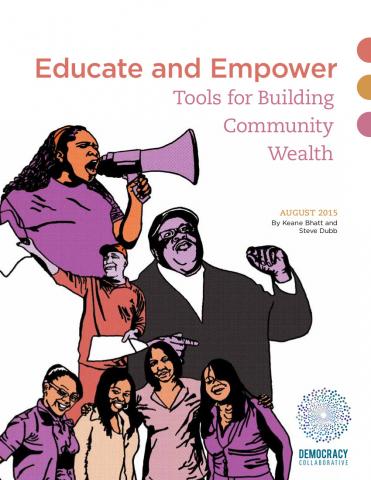How do low-income communities learn to advance economically and build wealth? Low-income communities and communities of color, in challenging structural economic and social inequality, have historically grappled with tensions inherent to development. Who participates in, directs, and ultimately owns the economic-development process? In creating and sustaining new, inclusive economic institutions, how do community members cultivate and pass on skills, commitment and knowledge—especially among those who have long faced barriers to education and employment? And how should communities strike an appropriate balance between utilizing local knowledge and accessing outside expertise?
INTRODUCTION
Can low-income communities create economic institutions that enable residents to build community wealth? This question animates Educate and Empower, a report that takes a hard look at the question of capacity building and the ways in which communities can become agents of community wealth building and empowerment. Authors Keane Bhatt and Steve Dubb examine eleven case studies of wealth building initiatives across the country. Some are storied models: Newark, New Jersey-based New Community Corporation, one of the nation’s oldest and largest community development corporations, began operations in 1967 in the crucible of the community’s collective response to urban unrest. Others represent more recent innovation: the Wellspring Cooperatives in Worcester, Massachusetts are a start-up effort that seeks to demonstrate that it is possible to leverage anchor institution procurement to develop a network of employee-owned cooperatives, even with limited resources.
Download the Educate and Empower report
TABLE OF CONTENTS
| Chapter 1: History: Community Development | |
| • | Education and the State |
| Chapter 2: The Comprehensive Approach to Community | |
| • | Education and Wealth Building |
| • | New Community Corporation, Newark, NJ |
| • | Market Creek Plaza, San Diego, CA |
| Chapter 3: Anchor Approaches to Education for Community Development | |
| • | Near Westside Initiative, Syracuse, NY |
| • | St. Joseph Health, Sonoma, CA |
| Chapter 4: Linking Community Organizing to Community Wealth Building | |
| • | Dudley Street Neighborhood Initiative, Roxbury, MA |
| • | PUSH Buffalo, Buffalo, NY |
| • | Wellspring Collaborative, Springfield, MA |
| Chapter 5: Community Building as Applied Education | |
| • | The Technical Assistance Model |
| • | Ohio Employee Ownership Center, Kent, OH |
| • | Paraprofessional Healthcare Institute, Bronx, NY |
| • | REDF, San Francisco, CA |
| • | Cooperation Texas, Austin, TX |
| Chapter 6: Emerging Lessons and Tools to Build Capacity | |
| Chapter 7: Conclusion | |
| Notes | |





